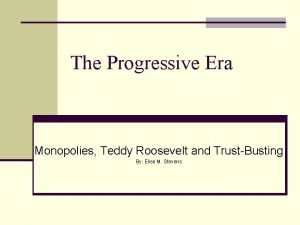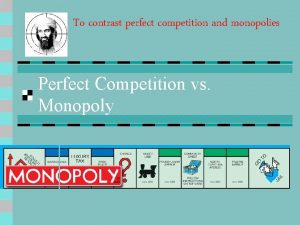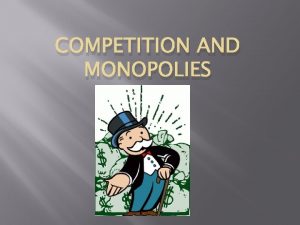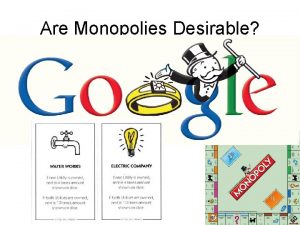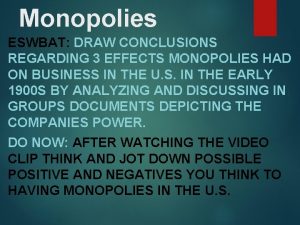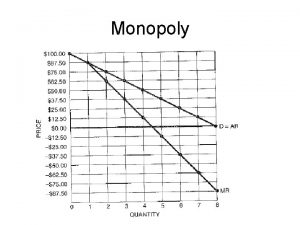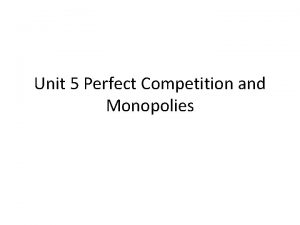Economics Chapter 9 Competition and Monopolies Perfect Competition









- Slides: 9

Economics Chapter 9 Competition and Monopolies

Perfect Competition: Section 1 n n Market Structure- the amount of competition they face. Perfect Competition A Large Market- many buyers and sellers. n A Nearly Identical Product n Easy entry and Exit n Easily Obtainable Information n Independence n

Perfect Competition n Prices are set by Supply and Demand. Information is the key n Agriculture as an Example n Farmers have no control of price, set by the market. n Demand inelastic while supply is dependent on outside factors. n Economic efficiency stressed. n

Monopoly, Oligopoly, Monopolistic Competition n Monopoly- single supplier controls market. Raise prices but not too high, law of demand kicks in. n Barriers to entry- They don’t allow new companies. n State Laws- electric companies n “excessive money capital costs”- Steel production n

Types of Monopolies n n Natural- Government grants exclusive rights. Cable, utilities, bus companies Geographic- business is isolated Technological- patents and copyrights Government- roads and bridge construction

Oligopoly n n Industry dominated by a few suppliers. Some control over price. Product Differentiation- minor differences in quality and features to differentiate. Interdependent Behavior- What one does others follow Collusion- illegally agreeing to raise prices. n Cartel n

Monopolistic Competition n n Large number of sellers offer similar products. Some control over price. Brand loyalty the key. Competitive advertising

Government Policies toward Competition n Antitrust Legislation and Mergers John D. Rockefeller n Interlocking directorates- board members serving on competing companies boards n Sherman Antitrust Act (1890)- prevent monopolies n Clayton Act (1914) n Merger- combining 2 or more corporations n Horizontal or vertical n Conglomerate- huge corporation n

Government Regulation n n From regulation to deregulation. 1980 s and 90 s less regulation and control of certain industries. FCC deregulation led to pay-TV n Foreign competitors the problem for U. S. firms. Auto industry. n
 Progressive era monopolies
Progressive era monopolies Monopoly vs perfect competition
Monopoly vs perfect competition Perfect competition vs monopolistic competition
Perfect competition vs monopolistic competition Competition refers to
Competition refers to Past perfect present perfect future perfect
Past perfect present perfect future perfect School of business and economics maastricht
School of business and economics maastricht Free entry and exit
Free entry and exit Perfect and perfect progressive tenses
Perfect and perfect progressive tenses Chapter 3 perfect and perfect progressive tenses
Chapter 3 perfect and perfect progressive tenses Market structure venn diagram
Market structure venn diagram
